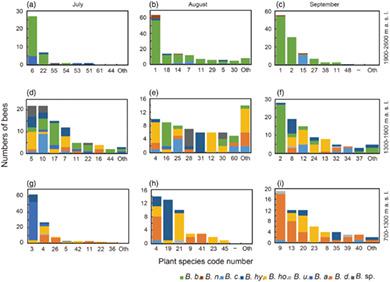当前位置:
X-MOL 学术
›
Ecol. Res.
›
论文详情
Our official English website, www.x-mol.net, welcomes your
feedback! (Note: you will need to create a separate account there.)
Contrasting altitudinal patterns of diversity between bumblebees and bumblebee-visited flowers: Poverty of bumblebee diversity in a high mountain of Japan
Ecological Research ( IF 1.7 ) Pub Date : 2019-01-15 , DOI: 10.1111/1440-1703.1010 Shin Egawa 1 , Takao Itino 2
Ecological Research ( IF 1.7 ) Pub Date : 2019-01-15 , DOI: 10.1111/1440-1703.1010 Shin Egawa 1 , Takao Itino 2
Affiliation

|
Funding information Research and Education Funding for Japanese Alps Inter-Universities Cooperative Project from MEXT; Ministry of Education, Culture, Sports, Science and Technology of Japan (MEXT), Grant/ Award Number: 15H02641; Ministry of the Environment of Japan, Grant/Award Number: D-0904 Abstract Range shifts of mountain organisms toward higher elevations in response to global warming may result in spatial mismatches between plants and their pollinators. Here, we aimed to examine whether bumblebee diversity decreases in a high-altitude zone, and whether it parallels a decrease in the altitudinal diversity of bumblebee-visited plants. We surveyed the alpha diversities of flower-visiting bumblebees and bumblebee-visited plants along an altitudinal gradient on a Japanese high mountain. Then, we examined whether the alpha diversities of bumblebees and bumblebeevisited plants could be explained by altitude, or by other factors such as season, surveyed area and flower abundance. We found that a model including only altitude best explained bumblebee diversity, and that flower abundance and plant diversity had considerable value in explaining bumblebee diversity. In contrast, none of the studied factors explained plant diversity. Bumblebee diversity was minimal in the high-altitude zone (1,900–2,600 m a.s.l.), where the only dominant bumblebee species, Bombus beaticola, visited many species of flowering plants. In contrast, five to seven bumblebee species were distributed in the low(700–1,300 m a.s.l.) and middle(1,300–1,900 m a.s.l.) altitude zones. These results show that plant– pollinator mutualism in high-altitude zone of a Japanese mountain is asymmetric: many bee-pollinated plants rely almost exclusively on one bumblebee species (B. beaticola) for pollination. Monitoring future changes in the distribution and abundance of B. beaticola is indispensable for the conservation of alpine plant in Japan.
中文翻译:

对比大黄蜂和大黄蜂造访花卉的海拔多样性模式:日本高山大黄蜂多样性的贫困
文部科学省日本阿尔卑斯大学间合作项目的资助信息研究和教育资助;日本文部科学省(MEXT),资助/奖励编号:15H02641;日本环境省,资助/奖励编号:D-0904 摘要 为响应全球变暖,山区生物的范围向更高海拔移动可能会导致植物与其授粉媒介之间的空间不匹配。在这里,我们旨在检查大黄蜂多样性是否在高海拔地区下降,以及它是否与大黄蜂访问过的植物的海拔多样性下降平行。我们在日本一座高山上沿海拔梯度调查了访花大黄蜂和探花大黄蜂植物的 alpha 多样性。然后,我们检查了大黄蜂和大黄蜂访问过的植物的 alpha 多样性是否可以用海拔来解释,或者用其他因素(如季节、调查面积和花卉丰度)来解释。我们发现仅包含海拔高度的模型最好地解释了大黄蜂的多样性,并且花卉丰度和植物多样性在解释大黄蜂多样性方面具有相当大的价值。相比之下,所研究的因素都没有解释植物多样性。在高海拔地区(海拔 1,900-2,600 米),大黄蜂的多样性最小,那里唯一的优势大黄蜂物种 Bombus beaticola 访问了许多开花植物。相比之下,5 到 7 种大黄蜂分布在低(700-1,300 m asl)和中(1,300-1,900 m asl)海拔区域。这些结果表明,日本山区高海拔地区的植物 - 传粉媒介互惠互利是不对称的:许多蜜蜂授粉植物几乎完全依赖一种大黄蜂(B. beaticola)进行授粉。监测 B. beaticola 分布和丰度的未来变化对于日本高山植物的保护是必不可少的。
更新日期:2019-01-15
中文翻译:

对比大黄蜂和大黄蜂造访花卉的海拔多样性模式:日本高山大黄蜂多样性的贫困
文部科学省日本阿尔卑斯大学间合作项目的资助信息研究和教育资助;日本文部科学省(MEXT),资助/奖励编号:15H02641;日本环境省,资助/奖励编号:D-0904 摘要 为响应全球变暖,山区生物的范围向更高海拔移动可能会导致植物与其授粉媒介之间的空间不匹配。在这里,我们旨在检查大黄蜂多样性是否在高海拔地区下降,以及它是否与大黄蜂访问过的植物的海拔多样性下降平行。我们在日本一座高山上沿海拔梯度调查了访花大黄蜂和探花大黄蜂植物的 alpha 多样性。然后,我们检查了大黄蜂和大黄蜂访问过的植物的 alpha 多样性是否可以用海拔来解释,或者用其他因素(如季节、调查面积和花卉丰度)来解释。我们发现仅包含海拔高度的模型最好地解释了大黄蜂的多样性,并且花卉丰度和植物多样性在解释大黄蜂多样性方面具有相当大的价值。相比之下,所研究的因素都没有解释植物多样性。在高海拔地区(海拔 1,900-2,600 米),大黄蜂的多样性最小,那里唯一的优势大黄蜂物种 Bombus beaticola 访问了许多开花植物。相比之下,5 到 7 种大黄蜂分布在低(700-1,300 m asl)和中(1,300-1,900 m asl)海拔区域。这些结果表明,日本山区高海拔地区的植物 - 传粉媒介互惠互利是不对称的:许多蜜蜂授粉植物几乎完全依赖一种大黄蜂(B. beaticola)进行授粉。监测 B. beaticola 分布和丰度的未来变化对于日本高山植物的保护是必不可少的。











































 京公网安备 11010802027423号
京公网安备 11010802027423号